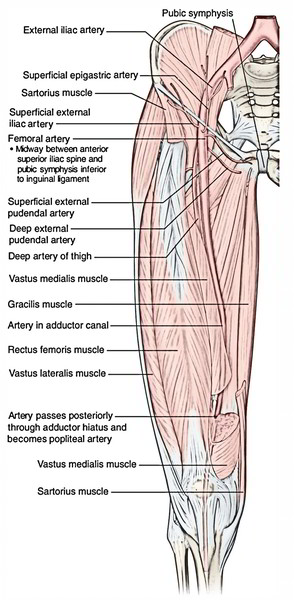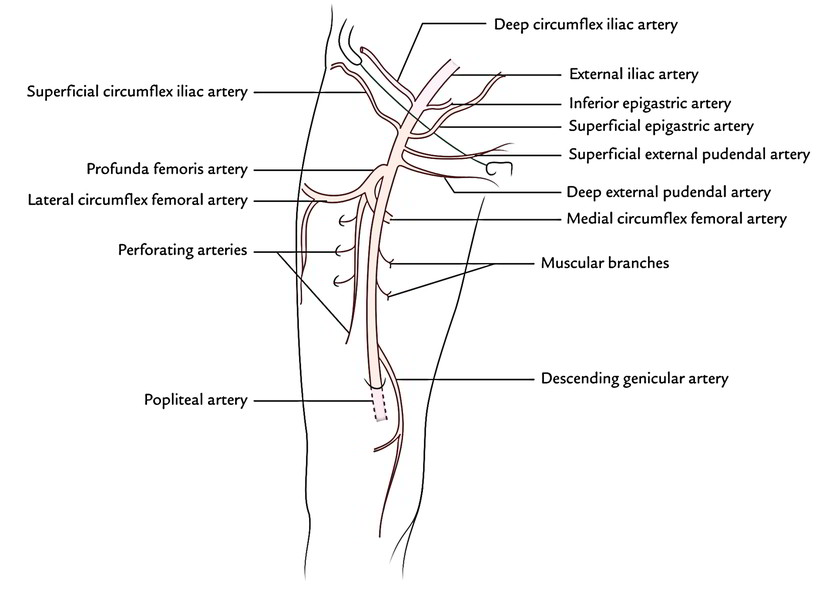Femoral Artery is the main artery of the lower limb. It’s the continuance of external iliac artery and enters the femoral triangle behind the inguinal ligament at the midinguinal stage. It runs downward and medially successively via the femoral triangle and adductor canal. At the lower end of the adductor canal (i.e., at the junction of middle one-third and lower one-third of the thigh), it leaves the thigh via the adductor hiatus (a tendinous opening in the adductor magnus) to goes into the popliteal fossa where it continues as the popliteal artery.
Surface Marking
Femoral ring: It is represented by a horizontal line 1.2 cm long over the inguinal ligament 1.2 cm medial to the midinguinal point.
Femoral artery: It is represented by the upper two-thirds of a line joining the midinguinal point to the adductor tubercle. The thigh is slightly flexed, abducted and laterally rotated.
Extent and Course
It passes downwards and medially. first in the femoral triangle, and then in the adductor canal. At the lower end of the adductor canal, i.e., at the junction of the middle and lower thirds of the thigh it passes through an opening in the adductor magnus to become continuous with the popliteal artery.
Relations of the Femoral Artery in the Femoral Triangle
1. The main anterior relations are the skin, superficial fascia, deep fascia and the anterior wall of the femoral sheath.
2. Posteriorly, the artery rests, from above downwards on the psoas major, the pecuneus, and the adductor longus. The posterior wall of the femoral sheath Intervenes between these structures and the artery sheath Intervenes between these structures and the artery.
3. The femoral artery is accompanied by the femoral vein. Just below the inguinal ligament the vein is medial to the artery. However, the vein gradually crosses to the lateral side posterior to the artery. It is directly behind the artery at the apex of the femoral triangle, and lateral to the lower end of the artery.
4. The femoral nerve is lateral to the upper part of the artery. Lower down the artery is related to the branches of the nerve, some of which cross it. The branch to the pectineus crosses behind the upper part of the artery. The medial cutaneous nerve of the thigh crosses the artery from lateral to medial side near the apex of the femoral triangle. The saphenous branch crosses the artery within the adductor canal. The nerve to the vastus medialis is lateral to the artery in the adductor canal.
5. The femoral branch of the genitofemoral nerve is also lateral to the upper part of the femoral artery, within the femoral sheath, but lower down it passes to the front of the artery.
6. The profunda femoris artery a branch of the femoral artery itself, and its companion vein, lie behind the upper part of the femoral artery, where it lies on the pectineus. Lower down, however, the femoral and profunda arteries are separated by the adductor longus.
Branches
In the femoral triangle:
- 3 superficial branches: Superficial epigastric artery, superficial external pudendal artery, and superficial circumflex iliac artery.
- 3 deep branches: Profunda femoris artery, deep external pudendal artery, and muscular branches.
In the adductor canal:
- Muscular branches.
- Descending genicular artery.
The deep external pudendal artery originates just below the superficial external pudendal artery and enters medially deep to the spermatic cord or round ligament of the uterus and supplies the scrotum or labium majus.
The descending genicular artery leaves the canal by descending inside the substance of vastus medialis and splits into articular and saphenous branches. The saphenous branch, also named saphenous artery, accompanies the saphenous nerve as it arises via the roof of adductor canal.
Alternative names of femoral artery: Some vascular surgeons, call the first part of femoral artery, proximal to the origin of profunda femoris artery as ‘common femoral artery’ and its continuance distally as ‘superficial femoral artery’.
Profunda Femoris Artery
This is the largest branch of the femoral artery. It is the chief artery of supply to all the three compartments of the thigh. It arises from the lateral side of the femoral artery about 4 cm below the inguinal ligament. The origin lies in front of the iliacus. As the artery descends, it passes posterior to the femoral vessels.
It leaves the femoral triangle by passing deep to the adductor longus. Continuing downwards, it passes first between the adductor longus and the adductor brevis, and then between the adductor longus and the adductor magnus. Its terminal part pierces the adductor magnus to anastomose with upper muscular branches of the popliteal artery. The profunda femoris artery gives off the medial and lateral circumflex femoral arteries, and four perforating arteries.
The medial circumflex femoral artery leaves the femoral triangle by passing posteriorly, between the pectineus and the psoas major muscles.
The lateral circumflex femoral artery runs laterally between the anterior and posterior divisions of the femoral nerve, passes behind the sartorius and the rectus femoris, and divides into ascending, transverse and descending branches. The ascending branch runs deep to the tensor fasciae latae, gives branches to the hip joint and the greater trochanter, and anastomoses with the superior gluteal artery. The transverse branch pierces the vastus lateralis and takes part in the cruciate anastomosis on the back of the thigh just below the greater trochanter. The descending branch runs down along the anterior border of the vastus lateralis, accompanied by the nerve to that muscle.
Clinical Significance
Compression, Palpation and Cannulation of Femoral Artery
- The femoral artery can be compressed against the femoral head at the midinguinal point to control the bleeding in the distal part of the limb.
- The pulsations of the femoral artery are felt by the clinicians in the femoral triangle just below the midinguinal stage.
- Since the femoral artery is very superficial in the femoral triangle, it’s the preferable artery for cannulation and injecting dye to do processes like angiography. It’s also the favored vessel for performing the coronary angiography and angioplasty.



 (63 votes, average: 4.49 out of 5)
(63 votes, average: 4.49 out of 5)